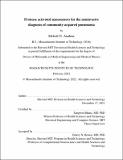Protease activated nanosensors for the noninvasive diagnosis of community-acquired pneumonia
Author(s)
Anahtar, Melodi N.
DownloadThesis PDF (3.480Mb)
Advisor
Bhatia, Sangeeta
Terms of use
Metadata
Show full item recordAbstract
Community-acquired pneumonia is the most common infectious cause of death worldwide, and is defined as an infection of the lung parenchyma. It is a heterogeneous disease caused by wide range of bacteria, viruses, and occasionally fungi. An arsenal of diagnostic tools have been developed to detect the many causes of CAP, yet in approximately 60% of CAP patients the causative organism is never determined. As such, the standard of practice for treating suspected CAP is to administer antibiotics as soon as possible because existing diagnostics cannot determine the etiology of disease quickly and accurately enough to warrant withholding treatment. This diagnostic and therapeutic paradigm is out of touch with the approaches to personalized medicine that are being taken for other diseases such as cancer, and an urgent need exists for an accurate and rapid pneumonia diagnostic that can simultaneously detect CAP and stratify etiology.
To address this gap, in this work we have developed two novel approaches to diagnosing CAP. Both approaches leverage differential protease expression by the host in response to pneumonia-causing pathogens to detect pneumonia and stratify etiology. To this end, we first derived a 40-gene signature from human transcriptomic data, which consisted of proteases biomarkers for pneumonia. We then used our lab’s activity-based nanosensor (ABN) technology to create a 20-plex panel of nanoparticles that could produce urinary signatures of disease state in response to the activity of a subset of these proteases. We validated that this panel could generate unique urinary signatures of disease in five in vivo mouse models of CAP within two hours of sensor administration. Using these signatures, we trained diagnostic classifiers to distinguish healthy mice from those with bacterial and viral pneumonia with high accuracy. To produce an even faster readout, we then modified these ABNs with volatile reporters to create breath-based volatile activity-based nanosensors (vABNs), and demonstrated that we that could detect pneumonia within 15 minutes of administration. Altogether, these nanosensors enable urine and breath-based detection of CAP, and constitute a means of diagnosing pneumonia that is orthogonal to existing clinical tests, thus opening a new direction of study for pneumonia diagnostics.
Date issued
2022-02Department
Harvard-MIT Program in Health Sciences and TechnologyPublisher
Massachusetts Institute of Technology